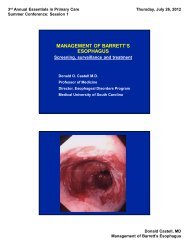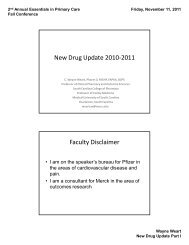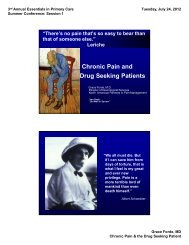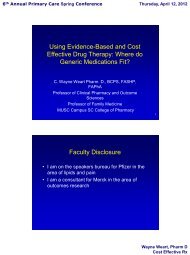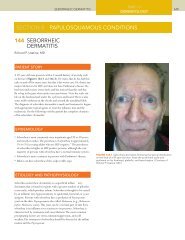atrial fibrillation and stroke prevention - Continuing Medical ...
atrial fibrillation and stroke prevention - Continuing Medical ...
atrial fibrillation and stroke prevention - Continuing Medical ...
Create successful ePaper yourself
Turn your PDF publications into a flip-book with our unique Google optimized e-Paper software.
Essentials in Primary Care Conference<br />
Wednesday, July 31, 2013<br />
Regardless of your Decision to<br />
Achieve Rhythm vs. Rate Control<br />
Choice of therapeutic strategy does<br />
not affect your decision regarding<br />
anticoagulation, i.e., achieving normal<br />
sinus rhythm does not allow one to<br />
stop anticoagulation-be it by<br />
-Antiarrythmic Rx<br />
-RF ablation<br />
-Cardioversion<br />
Asymptomatic Episodes More Common After<br />
Catheter Ablation for Atrial Fibrillation<br />
(DISCERN)*<br />
• Implantable Cardiac Monitor (ICM) placed<br />
3 months before <strong>and</strong> for a mean of 18<br />
months after RF ablation for AF in 50 pts<br />
• The ratio of asymptomatic to symptomatic<br />
AF episodes increased from 1.1 to 3.7<br />
(p=0.002)<br />
• Post-ablation state is the strongest<br />
predictor of asymptomatic AF with 12% of<br />
patients having asx recurrences only<br />
(DISCERN) Discerning Symptomatic <strong>and</strong> Asymptomatic Episodes Pre <strong>and</strong> Post Radiofrequency Ablation of<br />
Atrial Fibrillation<br />
Verma A et al. Jama Internal Medicine 2013;173 (2):149-156.<br />
Jan Basile, MD<br />
Atrial Fibrillation & Stroke Prevention




